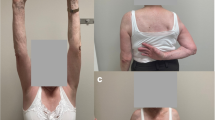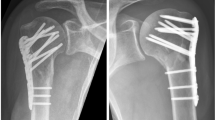Abstract
Introduction
Minimally invasive plate osteosynthesis (MIPO) has been described as a suitable technique for the treatment of proximal humerus fractures, but long-term functional results have never been reported. The aim of this study was to describe the long-term functional outcome and implant-related irritation after MIPO for proximal humerus fractures.
Methods
A long-term prospective cohort analysis was performed on all patients treated for a proximal humerus fracture using MIPO with a Philos plate (Synthes, Switzerland) between December 2007 and October 2010. The primary outcome was the QuickDASH score. Secondary outcome measures were the subjective shoulder value (SSV), implant related irritation and implant removal.
Results
Seventy-nine out of 97 patients (81%) with a mean age of 59 years were available for follow-up. The mean follow-up was 8.3 years (SD 0.8). The mean QuickDASH score was 5.6 (SD 14). The mean SSV was 92 (SD 11). Forty out of 79 patients (50.6%) had implant removal, and of those, 27/40 (67.5%) were due to implant-related irritation. On average, the implant was removed after 1.2 years (SD 0.5). In bivariate analysis, there was an association between the AO classification and the QuickDASH (p = 0.008).
Conclusion
Treatment of proximal humerus fractures using MIPO with Philos through a deltoid split approach showed promising results. A good function can be assumed due to the excellent scores of patient oriented questionnaires. However, about one-third of the patients will have a second operation for implant removal due to implant-related irritation.

Similar content being viewed by others
References
Jones CB, Sietsema DL, Williams DK (2011) Locked plating of proximal humeral fractures: is function affected by age, time, and fracture patterns? Clin Orthop Relat Res 469(12):3307–3316. https://doi.org/10.1007/s11999-011-1935-6
Kruithof RN, Formijne Jonkers HA, van der Ven DJC, van Olden GDJ, Timmers TK (2017) Functional and quality of life outcome after non-operatively managed proximal humeral fractures. J Orthop Traumatol. https://doi.org/10.1007/s10195-017-0468-5
Launonen AP, Lepola V, Saranko A, Flinkkila T, Laitinen M, Mattila VM (2015) Epidemiology of proximal humerus fractures. Arch Osteoporos 10:209. https://doi.org/10.1007/s11657-015-0209-4
Olerud P, Ahrengart L, Soderqvist A, Saving J, Tidermark J (2010) Quality of life and functional outcome after a 2-part proximal humeral fracture: a prospective cohort study on 50 patients treated with a locking plate. J Shoulder Elbow Surg 19(6):814–822. https://doi.org/10.1016/j.jse.2009.11.046
Palvanen M, Kannus P, Niemi S, Parkkari J (2006) Update in the epidemiology of proximal humeral fractures. Clin Orthop Relat Res 442:87–92
Rangan A, Handoll H, Brealey S, Jefferson L, Keding A, Martin BC, Goodchild L, Chuang LH, Hewitt C, Torgerson D (2015) Surgical vs nonsurgical treatment of adults with displaced fractures of the proximal humerus: the PROFHER randomized clinical trial. JAMA 313(10):1037–1047. https://doi.org/10.1001/jama.2015.1629
Court-Brown CM, Garg A, McQueen MM (2001) The epidemiology of proximal humeral fractures. Acta Orthop Scand 72(4):365–371. https://doi.org/10.1080/000164701753542023
Handoll HH, Brorson S (2015) Interventions for treating proximal humeral fractures in adults. Cochrane Database Syst Rev 11:Cd000434. https://doi.org/10.1002/14651858.CD000434.pub4
Jawa A, Burnikel D (2016) Treatment of proximal humeral fractures: a critical analysis review. JBJS Rev. https://doi.org/10.2106/jbjs.rvw.o.00003
Acklin YP, Stoffel K, Sommer C (2013) A prospective analysis of the functional and radiological outcomes of minimally invasive plating in proximal humerus fractures. Injury 44(4):456–460. https://doi.org/10.1016/j.injury.2012.09.010
Greiner S, Kaab MJ, Haas NP, Bail HJ (2009) Humeral head necrosis rate at mid-term follow-up after open reduction and angular stable plate fixation for proximal humeral fractures. Injury 40(2):186–191. https://doi.org/10.1016/j.injury.2008.05.030
Ockert B, Siebenburger G, Kettler M, Braunstein V, Mutschler W (2014) Long-term functional outcomes (median 10 years) after locked plating for displaced fractures of the proximal humerus. J Shoulder Elbow Surg 23(8):1223–1231. https://doi.org/10.1016/j.jse.2013.11.009
Acklin YP, Sommer C (2012) Plate fixation of proximal humerus fractures using the minimally invasive anterolateral delta split approach. Oper Orthop Traumatol 24(1):61–73. https://doi.org/10.1007/s00064-011-0051-9
Brunner F, Sommer C, Bahrs C, Heuwinkel R, Hafner C, Rillmann P, Kohut G, Ekelund A, Muller M, Audige L, Babst R (2009) Open reduction and internal fixation of proximal humerus fractures using a proximal humeral locked plate: a prospective multicenter analysis. J Orthop Trauma 23(3):163–172. https://doi.org/10.1097/BOT.0b013e3181920e5b
Falez F, Papalia M, Greco A, Teti A, Favetti F, Panegrossi G, Casella F, Necozione S (2016) Minimally invasive plate osteosynthesis in proximal humeral fractures: one-year results of a prospective multicenter study. Int Orthop 40(3):579–585. https://doi.org/10.1007/s00264-015-3069-z
Lin T, Xiao B, Ma X, Fu D, Yang S (2014) Minimally invasive plate osteosynthesis with a locking compression plate is superior to open reduction and internal fixation in the management of the proximal humerus fractures. BMC Musculoskelet Disord 15:206. https://doi.org/10.1186/1471-2474-15-206
Oh HK, Cho DY, Choo SK, Park JW, Park KC, Lee JI (2015) Lessons learned from treating patients with unstable multifragmentary fractures of the proximal humerus by minimal invasive plate osteosynthesis. Arch Orthop Trauma Surg 135(2):235–242. https://doi.org/10.1007/s00402-014-2138-x
Sohn HS, Jeon YS, Lee J, Shin SJ (2017) Clinical comparison between open plating and minimally invasive plate osteosynthesis for displaced proximal humeral fractures: a prospective randomized controlled trial. Injury 48(6):1175–1182. https://doi.org/10.1016/j.injury.2017.03.027
Sohn HS, Shin SJ (2014) Minimally invasive plate osteosynthesis for proximal humeral fractures: clinical and radiologic outcomes according to fracture type. J Shoulder Elbow Surg 23(9):1334–1340. https://doi.org/10.1016/j.jse.2013.12.018
Laflamme GY, Rouleau DM, Berry GK, Beaumont PH, Reindl R, Harvey EJ (2008) Percutaneous humeral plating of fractures of the proximal humerus: results of a prospective multicenter clinical trial. J Orthop Trauma 22(3):153–158. https://doi.org/10.1097/BOT.0b013e3181694f7d
Bahrs C, Kuhle L, Blumenstock G, Stockle U, Rolauffs B, Freude T (2015) Which parameters affect medium- to long-term results after angular stable plate fixation for proximal humeral fractures? J Shoulder Elbow Surg 24(5):727–732. https://doi.org/10.1016/j.jse.2014.08.009
Beaton DE, Wright JG, Katz JN (2005) Development of the QuickDASH: comparison of three item-reduction approaches. J Bone Joint Surg Am 87(5):1038–1046. https://doi.org/10.2106/jbjs.d.02060
Jost B, Pfirrmann CW, Gerber C, Switzerland Z (2000) Clinical outcome after structural failure of rotator cuff repairs. J Bone Joint Surg Am 82(3):304–314
Hulsmans MH, van Heijl M, Houwert RM, Hammacher ER, Meylaerts SA, Verhofstad MH, Dijkgraaf MG, Verleisdonk EJ (2017) High irritation and removal rates after plate or nail fixation in patients with displaced midshaft clavicle fractures. Clin Orthop Relat Res 475(2):532–539. https://doi.org/10.1007/s11999-016-5113-8
Angst F, Schwyzer HK, Aeschlimann A, Simmen BR, Goldhahn J (2011) Measures of adult shoulder function: Disabilities of the Arm, Shoulder, and Hand Questionnaire (DASH) and its short version (QuickDASH), Shoulder Pain and Disability Index (SPADI), American Shoulder and Elbow Surgeons (ASES) Society standardized shoulder assessment form, Constant (Murley) Score (CS), Simple Shoulder Test (SST), Oxford Shoulder Score (OSS), Shoulder Disability Questionnaire (SDQ), and Western Ontario Shoulder Instability Index (WOSI). Arthritis Care Res 63(Suppl 11):S174–S188. https://doi.org/10.1002/acr.20630
Gilbart MK, Gerber C (2007) Comparison of the subjective shoulder value and the constant score. J Shoulder Elbow Surg 16(6):717–721. https://doi.org/10.1016/j.jse.2007.02.123
Marsh JL, Slongo TF, Agel J, Broderick JS, Creevey W, DeCoster TA, Prokuski L, Sirkin MS, Ziran B, Henley B, Audige L (2007) Fracture and dislocation classification compendium—2007: Orthopaedic Trauma Association classification, database and outcomes committee. J Orthop Trauma 21(10 Suppl):S1–S133
Hirschmann MT, Fallegger B, Amsler F, Regazzoni P, Gross T (2011) Clinical longer-term results after internal fixation of proximal humerus fractures with a locking compression plate (PHILOS). J Orthop Trauma 25(5):286–293. https://doi.org/10.1097/BOT.0b013e3181f2b20e
Handoll HH, Keding A, Corbacho B, Brealey SD, Hewitt C, Rangan A (2017) Five-year follow-up results of the PROFHER trial comparing operative and non-operative treatment of adults with a displaced fracture of the proximal humerus. Bone Joint J 99-b(3):383–392. https://doi.org/10.1302/0301-620x.99b3.bjj-2016-1028
Acklin YP, Michelitsch C, Sommer C (2016) Elective implant removal in symptomatic patients after internal fixation of proximal humerus fractures improves clinical outcome. BMC Musculoskelet Disord 17:119. https://doi.org/10.1186/s12891-016-0977-z
Robinson CM, Khan LA, Akhtar MA (2006) Treatment of anterior fracture-dislocations of the proximal humerus by open reduction and internal fixation. J Bone Joint Surg Br Vol 88(4):502–508. https://doi.org/10.1302/0301-620x.88b4.17195
Acknowledgements
The authors thank Simone Kindle, study nurse, for her efforts in contacting and questioning all patients. They also thank Michelle Reynolds for the excellent copy-editing of this manuscript.
Funding
There was no external source of funding for this study.
Author information
Authors and Affiliations
Corresponding author
Ethics declarations
Conflict of interest
Herman Frima, Christian Michelitsch, Reinier B. Beks, Roderick M. Houwert, Yves P. Acklin and Christoph Sommer declare that they have no conflict of interest.
Ethical approval
All procedures performed in studies involving human participants were in accordance with the ethical standards of the institutional and/or national research committee and with the 1964 Helsinki declaration and its later amendments or comparable ethical standards.
Rights and permissions
About this article
Cite this article
Frima, H., Michelitsch, C., Beks, R.B. et al. Long-term follow-up after MIPO Philos plating for proximal humerus fractures. Arch Orthop Trauma Surg 139, 203–209 (2019). https://doi.org/10.1007/s00402-018-3063-1
Received:
Published:
Issue Date:
DOI: https://doi.org/10.1007/s00402-018-3063-1




